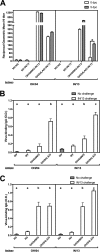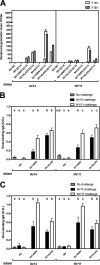Comparison of Adjuvanted-Whole Inactivated Virus and Live-Attenuated Virus Vaccines against Challenge with Contemporary, Antigenically Distinct H3N2 Influenza A Viruses
- PMID: 30185589
- PMCID: PMC6206469
- DOI: 10.1128/JVI.01323-18
Comparison of Adjuvanted-Whole Inactivated Virus and Live-Attenuated Virus Vaccines against Challenge with Contemporary, Antigenically Distinct H3N2 Influenza A Viruses
Abstract
Influenza A viruses in swine (IAV-S) circulating in the United States of America are phylogenetically and antigenically distinct. A human H3 hemagglutinin (HA) was introduced into the IAV-S gene pool in the late 1990s, sustained continued circulation, and evolved into five monophyletic genetic clades, H3 clades IV-A to -E, after 2009. Across these phylogenetic clades, distinct antigenic clusters were identified, with three clusters (cyan, red, and green antigenic cluster) among the most frequently detected antigenic phenotypes (Abente EJ, Santos J, Lewis NS, Gauger PC, Stratton J, et al. J Virol 90:8266-8280, 2016, https://doi.org/10.1128/JVI.01002-16). Although it was demonstrated that antigenic diversity of H3N2 IAV-S was associated with changes at a few amino acid positions in the head of the HA, the implications of this diversity for vaccine efficacy were not tested. Using antigenically representative H3N2 viruses, we compared whole inactivated virus (WIV) and live-attenuated influenza virus (LAIV) vaccines for protection against challenge with antigenically distinct H3N2 viruses in pigs. WIV provided partial protection against antigenically distinct viruses but did not prevent virus replication in the upper respiratory tract. In contrast, LAIV provided complete protection from disease and virus was not detected after challenge with antigenically distinct viruses.IMPORTANCE Due to the rapid evolution of the influenza A virus, vaccines require continuous strain updates. Additionally, the platform used to deliver the vaccine can have an impact on the breadth of protection. Currently, there are various vaccine platforms available to prevent influenza A virus infection in swine, and we experimentally tested two: adjuvanted-whole inactivated virus and live-attenuated virus. When challenged with an antigenically distinct virus, adjuvanted-whole inactivated virus provided partial protection, while live-attenuated virus provided effective protection. Additional strategies are required to broaden the protective properties of inactivated virus vaccines, given the dynamic antigenic landscape of cocirculating strains in North America, whereas live-attenuated vaccines may require less frequent strain updates, based on demonstrated cross-protection. Enhancing vaccine efficacy to control influenza infections in swine will help reduce the impact they have on swine production and reduce the risk of swine-to-human transmission.
Keywords: influenza; live-attenuated; swine; vaccine.
Figures




Similar articles
-
Oral Fluids as a Live-Animal Sample Source for Evaluating Cross-Reactivity and Cross-Protection following Intranasal Influenza A Virus Vaccination in Pigs.Clin Vaccine Immunol. 2015 Oct;22(10):1109-20. doi: 10.1128/CVI.00358-15. Epub 2015 Aug 19. Clin Vaccine Immunol. 2015. PMID: 26291090 Free PMC article.
-
Efficacy in pigs of inactivated and live attenuated influenza virus vaccines against infection and transmission of an emerging H3N2 similar to the 2011-2012 H3N2v.J Virol. 2013 Sep;87(17):9895-903. doi: 10.1128/JVI.01038-13. Epub 2013 Jul 3. J Virol. 2013. PMID: 23824815 Free PMC article.
-
Swine influenza virus vaccine serologic cross-reactivity to contemporary US swine H3N2 and efficacy in pigs infected with an H3N2 similar to 2011-2012 H3N2v.Influenza Other Respir Viruses. 2013 Dec;7 Suppl 4(Suppl 4):32-41. doi: 10.1111/irv.12189. Influenza Other Respir Viruses. 2013. PMID: 24224818 Free PMC article.
-
Novel Approaches for The Development of Live Attenuated Influenza Vaccines.Viruses. 2019 Feb 22;11(2):190. doi: 10.3390/v11020190. Viruses. 2019. PMID: 30813325 Free PMC article. Review.
-
Seasonal influenza vaccines.Curr Top Microbiol Immunol. 2009;333:43-82. doi: 10.1007/978-3-540-92165-3_3. Curr Top Microbiol Immunol. 2009. PMID: 19768400 Review.
Cited by
-
A gram-positive enhancer matrix particles vaccine displaying swine influenza virus hemagglutinin protects mice against lethal H1N1 viral challenge.Front Immunol. 2025 Jan 6;15:1432989. doi: 10.3389/fimmu.2024.1432989. eCollection 2024. Front Immunol. 2025. PMID: 39835123 Free PMC article.
-
A Replication-Defective Influenza Virus Harboring H5 and H7 Hemagglutinins Provides Protection against H5N1 and H7N9 Infection in Mice.J Virol. 2021 Jan 13;95(3):e02154-20. doi: 10.1128/JVI.02154-20. Print 2021 Jan 13. J Virol. 2021. PMID: 33177192 Free PMC article.
-
Impact of Pre-Existing Immunity to Influenza on Live-Attenuated Influenza Vaccine (LAIV) Immunogenicity.Vaccines (Basel). 2020 Nov 16;8(4):683. doi: 10.3390/vaccines8040683. Vaccines (Basel). 2020. PMID: 33207559 Free PMC article.
-
Development of a Novel Live Attenuated Influenza A Virus Vaccine Encoding the IgA-Inducing Protein.Vaccines (Basel). 2021 Jun 27;9(7):703. doi: 10.3390/vaccines9070703. Vaccines (Basel). 2021. PMID: 34198994 Free PMC article.
-
Immunogenicity and Protective Efficacy of a Recombinant Pichinde Viral-Vectored Vaccine Expressing Influenza Virus Hemagglutinin Antigen in Pigs.Vaccines (Basel). 2022 Aug 26;10(9):1400. doi: 10.3390/vaccines10091400. Vaccines (Basel). 2022. PMID: 36146478 Free PMC article.
References
-
- Jagger BW, Wise HM, Kash JC, Walters KA, Wills NM, Xiao YL, Dunfee RL, Schwartzman LM, Ozinsky A, Bell GL, Dalton RM, Lo A, Efstathiou S, Atkins JF, Firth AE, Taubenberger JK, Digard P. 2012. An overlapping protein-coding region in influenza A virus segment 3 modulates the host response. Science 337:199–204. doi:10.1126/science.1222213. - DOI - PMC - PubMed
Publication types
MeSH terms
Substances
Grants and funding
LinkOut - more resources
Full Text Sources
Other Literature Sources
Medical
Miscellaneous

